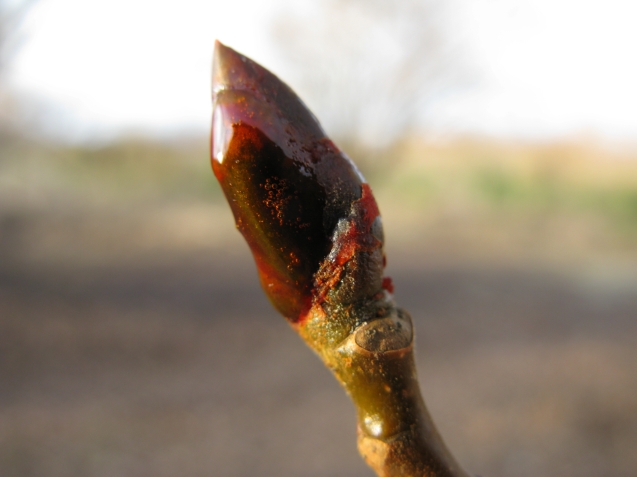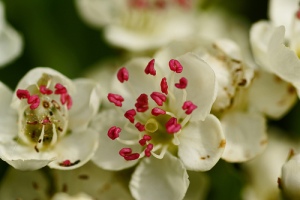You are currently browsing the category archive for the ‘observation’ category.
Kiva Rose’s plant profile on using poplar as medicine. But really I just wanted an excuse to post this photo from July…
A friend and I have had several conversations recently about hawthorn. One of the things we had both been thinking about was the scent of hawthorn blossom. To some people it smells lovely, to others it smells rotten. Apparently there are two things going on there. Amygdalin is responsible for the attractive smell (the marzipan one, smells like almonds) and attracts bees. The other smell is apparently like decomposing flesh, and attracts insects who like that sort of thing, who also help pollinate (presumably flies). I don’t really smell the rotten scent, it’s there as an undertone sometimes but mostly I find the smell divine. But my friend’s partner can’t stand the smell. She wondered if it’s a male/female thing. I wondered if it’s to do with who needs what medicine (and smell receptors in the nose and brain). Probably where the tree is growing, and what the climate is like will have an influence as well. British sources speculate that different species of hawthorn have more of one smell than the other, but as far as I know the local species are all Crataegus monogyna.
Smell is a very useful tool in learning about medicine and which ones to take. The smell of a plant will signal to the body certain things about what the plant contains. If the plant is taken over time the body gets to know it, and then the smell can signal at other times that it’s right to be taking that medicine. Possibly my friend and I would do well with hawthorn blossom as medicine, but not her mate.
Although I’ve used the berries in tinctures and vinegars I’m new to hawthorn flowers and leaves as medicine. My initial ways of getting to know the plant include tasting, making infusions and tea, reading other people’s experiences, talking to my friend and visiting the plant often to see what is going on.
I started by tasting the flowers and was a bit surprised at an obvious bitter taste. It wasn’t overpowering, and it lessened with older flowers, but I had read about making such delights as hawthorn flower syrup and wine cup where you would expect a strong pleasant taste. The bitterness wasn’t offputting though and bitter is a very good flavour for human health, one that is missing from most modern diets, so a little bitter in my hawthorn is a good thing.
However once the flowers are steeped in hot water, the tea brings out the true hawthorn flavour. The bitterness is there in the background, but also a distinct pungent almost sweet flavour. Not sweet like sugar, but the subtle nectar of a small flower*. There’s also a greeness, as expected from the leaves. I made some blossom and leaf tea, about a cup of fresh flowers to 3 cups water, and drank some after 10 minutes, 30 minutes, and an hour.
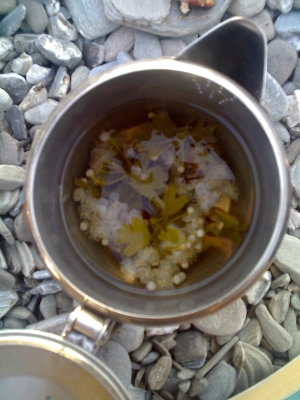
I found the brew almost immediately relaxing. It made me a bit sleepy, not a sedative but it definitely mellowed me out after a tense afternoon. The later stronger brew was even more so. I also found it relaxing to my digestive tract. After 10 minutes the tea had a green subtle taste. 30 mins and it was sweeter, still a bit green. In an hour a subtle bitter taste came through, might be from the bottom of the pot or the longer brewing.
Since then I’ve been making infusions and enjoying a couple of cups a day when I need to unwind. I’ve found hawthorn berry tincture has a similar kind of relaxant effect.
Hawthorn is well known as a heart tonic. In the US the focus seems to be on the berries, but I’ve been interested to see British and European sources talk about the leaves and flowers as the best medicine. Hawthorn’s ability to nourish the heart and assist in recovery from heart problems is well documented in traditional herbalism, contemporary herbalism and supported by science.
In the past week I’ve been harvesting the leaf and bloom clusters to dry for tea later once the spring is past. When you harvest make sure that you get flowers that aren’t too old. Give the branch a gentle shake and if some of the petals fall off it means the flowers are nearly done. They’re probably less potent and they’re likely to fall apart when you harvest and not dry so well.
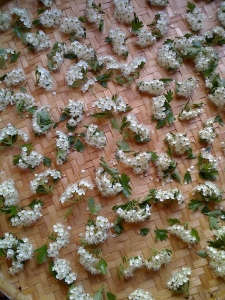
The flowers and leaves seem to dry easily. I’ve got them spread out on a cane tray and give them a shuffle every now and again. It’s a good idea to keep each cluster as separate as possible, they dry better that way. When they’re crisply dry I’ll store them in dark glass or paper bags.
*I did watch the bees on the flowers one day, and they were definitely feeding on something I had trouble finding. Hawthorn flowers have a single central pistil (that’s the monogyna bit in the Latin name)…
The pistil is the yellow tipped bit in the middle. At the bottom of that where it meets the petals was were the bees were feeding from. I couldn’t see anything that looked like nectar, but taking the flower apart and eating that middle bit yielded the sweetness.
Btw, that photo is from flickr (not a chance on my cellphone camera), and someone has left a comment there about how the pollen on the stamens looks like tiny red hearts! Brilliant. The pinkness doesn’t last though, and on most of the flowers I harvested the stamen end was black.
Further reading:
Brigitte of myherbcorner has a recent post on hawthorn.
Susun Weed’s article on hawthorn as a heart medicine.
For a long time I’ve been wanting to learn/observe enough about the world I live in to be able to name the full moon each month according to what happens in nature at that time every year. This is a traditional practice in land based cultures – we know it in popular culture from Native American tribes. It’s a practical way of focussing on important natural events as well as keeping track of time (especially important in oral cultures). It also seems to be linked deeply to celebration.
Full moon naming is always going to be regional. This full moon (exact in two days) seems so obviously about the hawthorn blossoming, but maybe that isn’t true where you live. Perhaps hawthorns aren’t prolific where you live, or there is something else going on that is more pertinent. I’m also considering calling this moon Rabbit Moon because in the last few weeks the rabbits have all come out. However that seems like it could be something that varies much more according to how the season is going – the rabbits might peak much earlier or later depending on the weather, food sources etc. Hawthorn seems much more likely to be always (or mostly) blooming at this time. I could of course be wrong about that, I’ll have to wait for next year and the year after and the year after, and so on, to find out.
In the UK, the Hawthorn is called the May tree, because it flowers in time for the first of May (which is roughly the seasonal equivalent of the first of November). A traditional name so closely tied to a specific time suggests some reliability to hawthorn flowering.
Full moon naming should ideally be cultural too i.e. it should arise naturally from human observation and interaction with nature over a very long period of time. Because this is not currently important in NZ I have no idea what to call each moon, and it will be years before I can know if I am right about the names I choose, and even then the naming will have happened in isolation rather than arising out of our collective practice. But we have to start somewhere. It strikes me as one practical way of reconnecting ourselves with the land and re-establishing right relationship with where we live. One of the curses of the modern age is our lack of long time frames to understand the consequences of our actions. Learning how to name the moon again will help us hold a longer view in our hearts and minds. It grounds us not just in where we are today (or this year) but also in where we have come from and where we are heading.
What happens in nature to coincide with full moons is also dependent on the sun. The moon influences tides and hormones and all that watery stuff. The sun changes the world through light and heat. Both have an effect as they move closer and futher away. The sun over the year, the moon varying hugely from month to month. This month, the full moon is very close to the earth (perigee is on the 8th), which will bring big high and low tides.
This full moon is also closely linked to the cross quarter date of 31st October. It’s the point between the spring equinox (September 23, when the sun is half way between summer and winter) and the summer solstice (December 23, when the sun is at its height). But the moon dates move in relationship to the sun, so sometimes the full moon will be closer or further away from the solar marker dates. I have read somewhere that European pagan societies marked the year by the nearest full moon (or dark moon) to a certain solar time. So rather than the spring solstice exact, the celebration was at the nearest full moon to the spring solstice. We do this still with Easter, which falls on the first Sunday after the first full moon after the spring equinox in the northern hemisphere (our autumn). Maori do this also with Matariki (the Maori/Polynesian new year), which for some iwi is the first new moon following the rise of Matariki/Plieades in June (a stellar marker rather than a solar one).
Back to hawthorn. In the UK it seems to have a long tradition as a magic or spiritually potent plant. This makes so much sense to me – hawthorn in bloom seems the epitome of how the Brits have envisioned the fairy realms:
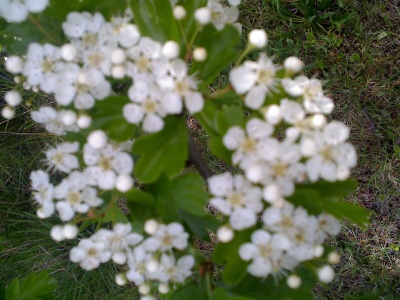
I had a cold last week, only it was a hot one. What I mean by that is that I had a rhino virus (a ‘cold’) where the symptoms were signs of heat in my body not signs of coldness. I had had a few days of coughing up gunk from my lungs following some dusty work earlier in the week. By mid week my face and head became hot, and my nose was very dry. I was also tired in the viral infection kind of way, and craving cooling foods and drinks. And I was coughing ‘unproductively’ (meaning phlegm needed to come out but wasn’t). This is quite different than a cold cold, where you might feel cold in your body and crave warming foods and drinks.
My two main remedies were sleep and mullein infusion. Sleep and/or rest is by far the most important thing to do to recover from colds or flu’s well. The body needs energy to focus on the immune response (both increasing immune cell responses and removing the breakdown products via the lymphatic system). If we keep up our normal level of activity it can make it harder for our bodies to fight the infection.
Mullein is a wonderful healer of many lung complaints, including colds, bronchitis and asthma. It’s useful for the whole upper respiratory tract as well, but seems particularly gifted when it comes to lungs. Nourishing, soothing and moistening to mucous membranes mullein helps expel phlegm from the lungs. It is cooling which made it perfect for this cold. I normally get cold colds and so don’t use mullein often as a cold remedy (I prefer thyme). But this week it was a blessing. I picked 5 large fresh leaves…
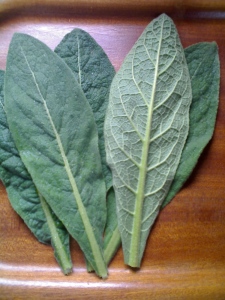
chopped them into a pot, covering them with 2 cups of boiling water…
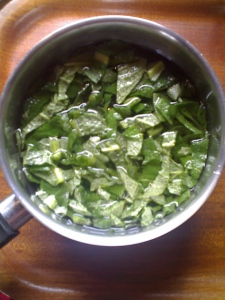
and simmered gently for a while (with a lid on).
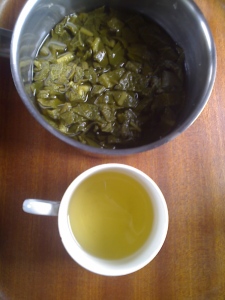
That pot has had some infusion taken out – the simmering shouldn’t reduce the amount of liquid much, but it provides enough heat to help break down the cell walls of fresh plants (not needed if the plant is dried). Mullein needs to be strained through a cloth to remove the fine hairs that can irritated the throat.
You could make an infusion like this without simmering, using fresh leaves, or dried. Dried leaves give a stronger medicine, but I’ve been partial to fresh plant infusions of mullein recently. It’s easy to make, and the plants are in full growth spurt, lush and abundant where I am, so it makes sense to use them for medicine at this time when they are so vibrant. I make mullein leaf tincture to use at other times and find it effective with many lung problems too.
I also made some calendula infusion (about a handful of whole flowers to a litre of boiling water, steeped for half an hour, preferably longer), which I drank later in the day to help my lymphatic system.
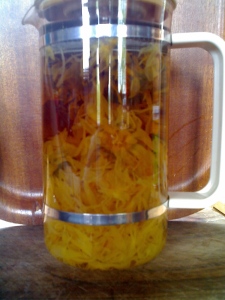
I drank several cups of the mullein infusion over the morning and afternoon, and the calendula in the evening. I had several naps during the day, ate a clove of garlic and vitamin C foods, and avoided exertion and stress. By the time I went to bed I felt fine. A few days later I got a bit chesty again (having been an idiot and overdone it work-wise), but another day of drinking mullein set me right.
If you have mullein local to you, try making an infusion and see what it is like. It’s good to get to know medicines before we really need them, and it’s good to be familiar with preparing them when we aren’t feel like crap. We’re much more likely to use them if we already have the practice.
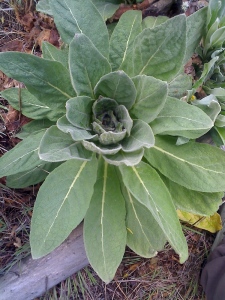
When I was out the other I came across some council trees. They’re maybe 4 or 5 years old. They’re between the road and a large empty paddock that gets mown several times a year but where the grass is still thick and abundant.
The area around the base of the trees is bare dirt for maybe a 2 – 3 metres diameter and the rabbits have been going beserk, making extravagantly big holes. I was curious about this – some time ago it was pointed out to me that rabbits thrive where the grass is really short. That’s why you have rabbit problems where there is sheep grazing (because most farmers graze pasture very low).
Bearing this in mind I look around to see where else the rabbits are making homes. And sure enough, the only places there are holes is where there the grass has been disturbed or is very short. Most of the paddock is thick grass up to five inches tall but generally less than that and there were no rabbit holes there at all. But where the grass had been dug into by humans or sprayed, there were holes.
Here’s the irony. The council were obviously spraying around the trees to keep the grass down, and then the rabbits where coming along and digging because it’s the only accessible dirt in the area. The spraying is unnecessary as these older trees won’t be adversely affected by long grass. I guess it’s a cosmetic thing, you can’t have long grass in a town, it looks messy. Messier than dead grass, bare earth, rabbit holes and pesticide residue.
So go rabbits I say. If humans are going to do stupid things, then nature will point it out.
Solutions? Personally I don’t mind long grass and would take that over pesticide use any day. I accept that that is too much for many people, so how about wild herbaceous borders that act as mini wildlife preserves or corridors? The strip of land where these trees were growing could be seeded with local wildflowers, in this case yarrow, vipers bugloss, st john’s wort, wild carrot, dandelion, red clover and curly dock (they just all happen to be medicinal, heh). This would encourage abundant insect life, including food for bees and predator insects that control ‘pest’ insects (which would also benefit nearby gardens).
Grasses could be included (especially some of the more aesthetic ones), which would provide food for small birds. If the trees were fruit or nut trees, then the undergrowth could be a permaculture orchard using plants beneficial for predator and pollinating insects eg feral parnsip which when flowering attracts insects and when seeding is elegant (I have a thing for umbelliferae).
In permaculture there is a technique called a guild. This is where you have a cluster of plants that work together for the benefit of each other. In this example each food bearing tree could form the centre of a guild that included plants that act as mulch and ground cover (preserving soil moisture), insect attractors (pest control and pollination), increase fertility and provide nutrients, and provide beauty. You can read more about guilds here.
Last year I found myself yelling at the TV when I saw one of Te Radar’s back to the land episodes. He was digging up dandelions, potting them up and trying to sell them at the local market. It’s actually not a bad idea, given what a useful food and medicine plant it is, but what made me yell was that a number of the plants he had weren’t dandelion at all. They were one of the dandelion look-alikes . It’s a really common mistake, almost as common as dandelion itself.
Dandelion and its look-alikes are members of the Asteraceae family. They have similar-ish leaves and similar bright yellow flowers. There’s quite a few look-alikes with confusing but intriguing names: catsear, hawkbit, hawsbeard, beaked hawksbeard, hawkweed etc (Hypochoeris, Crepis, Leontodon, and Hieracium spp).
Te Radar’s mistake was kind of funny, but kind of not too. If you are going to eat weeds, it pays to know which ones you are eating. As far as I know all the look-alikes, including Radar’s one (which was most likely a catsear) are edible but not particularly palatable. So you don’t really need to learn how to ID them because if you get one instead of a dandelion it won’t hurt you. There are some plant families where making such a mistake could cost you your life – I’ve mentioned the Umbelliferae family which contains such wild edibles as carrot, fennel, and sweet cicely as well as the deadly hemlock.
Being able to ID a dandelion is really useful though, not only for food but essential for medicine. Plus you can impress your friends when they point to a catsear and call it a dandelion.
Here’s how to tell a dandelion – Taraxacum officinale, from it’s cousins:
1. Dandelion blossoms are always one flower to one stalk. If there is more than one flower to a stalk it’s not a dandelion.
2. Dandelion’s have multiple blossom stalks that don’t branch. If there any branches on flower stalks, it’s not a dandelion.
3. Flower stalks are always hollow, and yield a white sap when broken. If the flower stalk isn’t hollow it’s not a dandelion.
4. Dandelions grow in rosettes from the ground. They never send up stalks with leaves on them. If there are stalks with leaves on them, it’s not a dandelion.
5. The leaves have no hairs on the rib on the back of the leaf (there may be a white fluff). This is a key to identifying dandelion when it’s not in flower. If there are hairs, it’s not a dandelion.
Dandelion leaves vary in shape, but generally have a classic jagged edge. Young ones may look rounder.
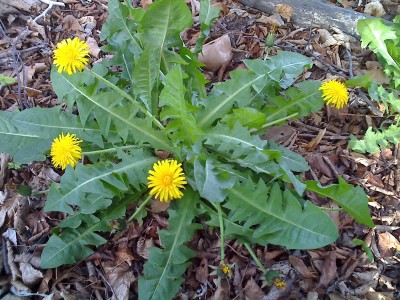
I admit, I just wrote this post today so I had an excuse to post photos of these glorious dandelions in flower. This one show the classic toothed leaf of the plant (dent de lion is French for lion’s tooth. I don’t know if lion’s teeth bear any resemblance or if the French are being poetic).
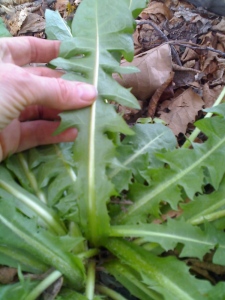
The hairless rib on the back of the leaf.
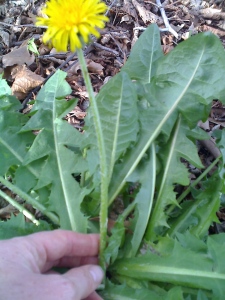
Non-branching stalk, one flower.
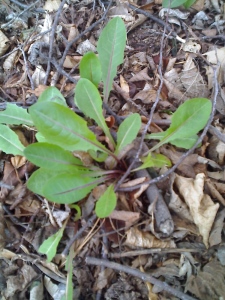
Young dandelions that don’t have any teeth yet.
Dandelion is a incredibly versatile plant. All of it can be eaten (maybe not the seeds), and all of it is medicine. Things to do with dandelion at this time of year:
~ make dandelion blossom oil (fantastic for massaging tight, aching muscles, especially neck and shoulders).
~ make dandelion blossom vinegar.
~ use blossom buds in salads, stirfries and omelettes (add near the end).
~ harvest young leaves from non-flowering plants (better get in quick as they’re starting to bloom) and eat in salads or cook well in garlic and butter and season with salt and lemon juice or vinegar. Once dandelion starts to flower the leaves get more bitter (this may not be a problem depending on your tolerance for bitter).
Most parts of the plant are high in minerals and vitamins, making dandelion an excellent addition to the diet.
Dandelion is a particular medicine of the liver and kidneys. The bitter taste varies in different parts of the plant and changes over the course of the year. Bitter stimulates digestion and production of bile. Dandelion can also make you pee more, so take care not to over do it if that’s likely to be a problem.
I went out today following my nose looking for weeds. My mood is good and I move past the harsh reality that I would have to drive at least an hour to find an intact native ecosystem or even a thriving mixed one. I will take what is on offer – there is comfort to be had from the land that is trying to heal. When I arrive there are 3 kahu hunting rabbits in the paddock. A good sign. One of the kahu is very large, which means it’s an older bird. But the rabbits are big too, I’d like to come back and see the hunt in action.
I wander around and down to the river. It’s all broom and willow and small plants of succession. It’s easy to understand why the river bed is the way it is (flooding limits what can grow here) but harder to make sense of the land up on the banks, rabbit riven, dry, sparse. The paddocks nearby are mown for some reason, but stock have been here too at some stage, which explains why there are so many rabbits (rabbits don’t like long grass) and why only the big trees, inedible shrubs and first sucession plants survive. There is no moving on.
Still it is a beautiful late afternoon and on my way back from the river I come across an oasis. It’s a large double willow. Underneath is a pile of what has been dumped earth and gravel, several metres high and four or five in diameter.. Over the top of this are the lush green plants, especially the annuals that bring advancing fertility each time they die and feed the soil.
I wander around the mound delighted in the abundance of edible and medicinal plants:
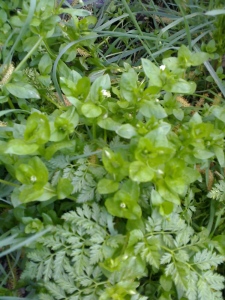
Chickweed – Stellaria media (the brighter green plant) and hemlock – Conium maculatum (the ferny looking one). Eat the chickweed and make medicine from it. Don’t do anything with the hemlock that involves putting it in or on your body, and take special care with look alike edible and medicinal plants from the same family (Umbelliferae) because hemlock is so poisonous. There was enough chickweed here today to eat handfuls while I was looking around. I took some care to make sure my handfuls weren’t mixed with hemlock though.
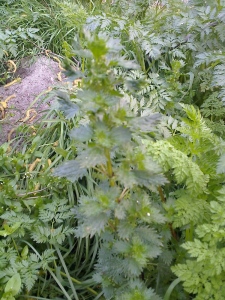
That’s the annual nettle, Urtica urens. A bit tricky to eat because it flowers so early and the leaves aren’t great on nettle once it’s flowering. But it makes fantastic fertiliser, so I am happy to see it in this garden.
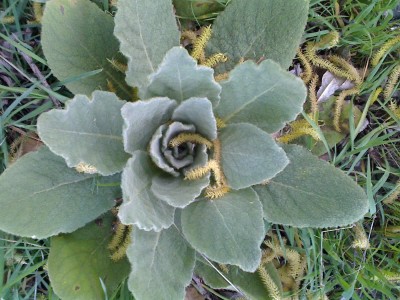
Mullein – Verbascum thapsus. Darling medicine of dry lands, it’s a good general lung healing herb (more on that soon). Seriously not edible – furry and with small hairs that will drive your throat crazy – always strain herbal preparations through a cloth.
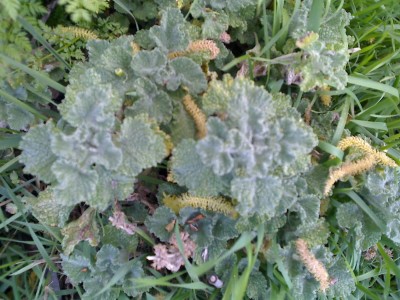
Horehound – Marrubium vulgare. Another medicinal plant, most well known as a cough remedy. Very bitter.
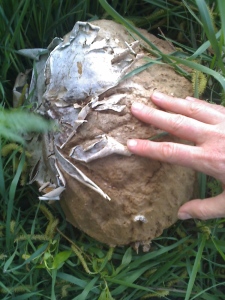
Giant puffball!!! – Calvatia gigantea. I’ve never seen one of these before, they’re apparently a bit rare. It’s past its edibleness, but still a very exciting find. The white bits are the outer cover that has peeled back as the ball had puffed. The brown bit is spongy and sends of clouds out brown spores when you poke it. Even better and more delightful was that once I’d spotted this one, I saw half a dozen others, more decomposed, hiding in the grass:
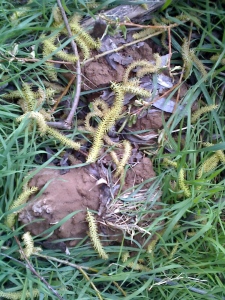
Yep, that is a puffball, collapsing in on itself. They were spread out around half the mound. The puffball bit is the fruit of the fungi. The body of the plant, the mycelium, is underground. I don’t know much about puffballs yet (other than they are edible and the small species is yummy), but mycelium can grow over a much wider area than what you see above ground so I’ve probably been walking on puffball the whole time.
Fungi are the coolest of the cool, very important for ecosystem health especially ones restoring, and they make fantastic people food and medicine. Expect more raving posts about them.
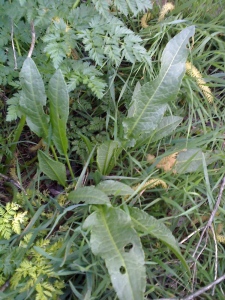
Yellow Dock – Rumex crispus, aka curly dock (you can see the curl especially on the left edge of the leaf in the bottom of the photo). Medicine and food. This is a lovely young succulent looking plant. Possibly even a first year, as I didn’t see any old seed stalks from the autumn. This suggests that the pile of earth has been dumped recently (and this plant came in with that or grew up through).
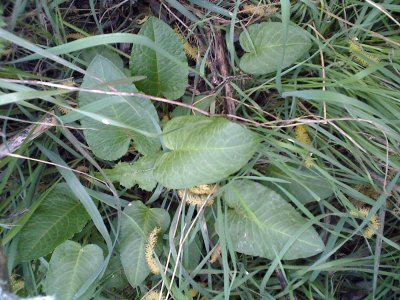
Broad leaf Dock – Rumex obtusifolia (I think). Interchangeable with Yellow Dock, but for some reason I prefer the yellow. Again a young looking plant. The leaves of both docks are tart with oxalic acid. Some people have a higher tolerance for this than others, but if you like it cook it well like spinach. Most edible weed books will have ideas about cooking docks.
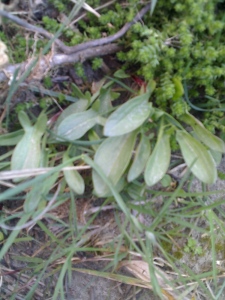
Sheep’s sorrel – Rumex acetosella. Not growing in the garden but nearby. I wanted to include it because it’s related to the docks, and has a delicious sharp lemony taste making it perfect as a garnish or addition to salads. It’s on my to do list to collect seeds for inclusion in a wild greens salad growing mix. Sheep’s sorrel is a small plant, although these ones are a decent size. You can’t tell from the picture but the leaf is maybe an inch and a half long.
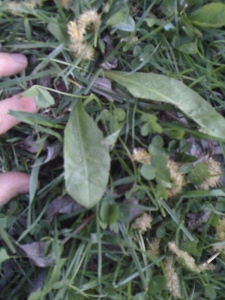
A mystery plant growing out in the mown paddock and on the flat around the willow. I broke the cardinal rule of wildcrafting and grazed on this while wondering what it was (don’t do this at home folks i.e. never eat a plant that you can’t identify). It’s dandelion like, but isn’t dandelion. Possibly chicory, and perhaps it’s been sown in this place in the past. It was bitter but not as much as dandelion, and fresh.
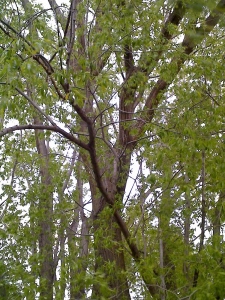
The beautiful tree that made all this possible. We have such a downer on wild willows in this country, but they are incredibly helpful plants. Not only are they medicine trees, but they assist degraded landscapes by keeping the water table high enough for other plants to grow nearby. A friend told me about this recently, and when I looked at this place today it was true that all around the tree, including on the north side, there is more lush growth than away from the tree. The lushness lasts well beyond the shade offered, and past the drip line.
After all that I lay in the grass and watched the sky and crescent moon overhead. It was hard not to think I had been brought here. You can take that literally or poetically, but there is no doubt that the more I open to nature the more it shares with me.
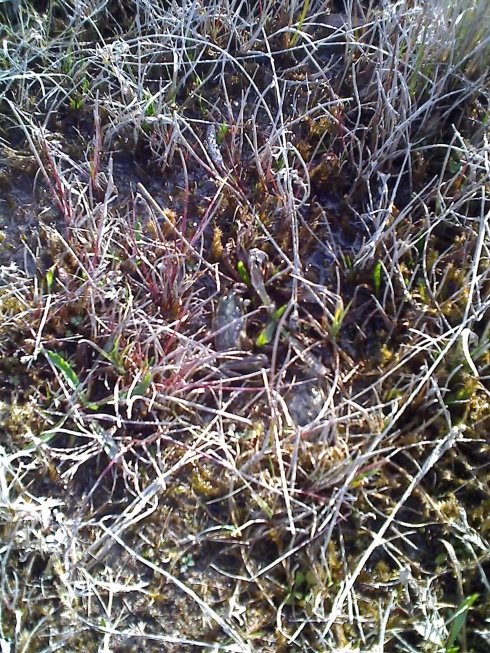
Everyone knows how to make herbal tea. Regular tea is a kind of herbal tea – it’s made from the herb Camellia sinensis*. So anyone who has made gumboot will understand the basic principles of making a water based herbal medicine. You need hot water, dried herb, and something to brew in.
But beyond that, water based herbal medicines vary depending on what you are trying to achieve. There are teas, infusions, and decoctions for internal use. As I mentioned in another post, those terms get used interchangeably and contradictorily by different people, so here is what I personally mean in this blog when I use those words:
Tea: a small amount of herb steeped in hot water for a shortish amount of time. Can be a refreshment or a medicine, but is less strong than an infusion.
Infusion: a large amount of herb steeped in water for a long period of time. The greater amount of herb and the longer time both mean a stronger medicine and more parts of the plant are extracted.
Decoction: simmering herb in water, or simmering an infusion to reduce it down and increase the strength of the brew. Decoctions are by definition stronger than teas or infusions.
Some important principles:
One of the ways plants protect themselves is by having very thick cell walls. In order to get to the nourishing and medicinal bits of the plant inside the cells we have to break the cell wall. Three things will do that in water preparations: drying, heat and time.
Drying: for the most part dried herb will extract into water far better than fresh plant. You can try this for yourself. Find a non-aromatic herb that you have both dried and fresh eg nettle, raspberry leaf, or calendula. Make a tea from the dried and from the fresh by putting 1 tsp into 1 cup of hot water. Cover and leave for 15 minutes and then compare taste, smell and what they look like.
Having said that, some herbs extract well as fresh plants. These are herb that are high in volatile oils (the aromatic oils you can smell) eg mint, rosemary, thyme, lemon balm. You can make water medicines from these as fresh plants because the volatile oils may be the medicinal parts you want and they extract into the water very easily (and if it’s the volatile oils you are after, they often extract better from fresh plant than from dried). They also smell great.
Heat: heat will break down plant cell walls (this is true of food too, and is one reason why well cooked food is often easier to digest and more nutritious). Hot water, just boiled, is perfect for tea and infusion making, extracting most plant parts more effectively than cold water. Hot water and dried plants are a good match. Again, you can try this yourself. Take some dried herb and make a tea from hot water and one from cold water, and then compare after 15 minutes.
Decoctions also use hot water, but hotter than in tea or infusion. With a decoction, you simmer the herb, or heat it just below simmer, for a period of time. This additional exposure to heat will break down tougher cell walls and so is used for tougher plant parts like roots and barks. It can also be used for fresh plant, where there has been no drying to assist the cell wall breakdown. Rongoa (Maori herbal medicine) seems to be a tradition that uses decoctions more than infusions, presumably because of the easy availability of fresh plant.
And again there are exceptions to the rule. Some plants have mucilage in them, a substance that produces slimey or jelly like medicines that are good for soothing mucous membranes eg the digestive tract. Mallows and marshmallow are classic examples of this. Mucilage extracts very well into cold water.
Time: and thirdly, time allows for greater extraction of medicine from the plants. The longer you leave a tea or infusion to brew the stronger it will be. This is important if you are wanting to get nutrients like minerals from herbs, as it takes time for them to extract into the water. An over night infusion will have more minerals in it than a 20 minute infusion.
It is possible to brew some herbs for too long. Chamomile is best brewed (as a tea) for no more than 20 or 30 minutes, otherwise it gets quite bitter.
You can use any combination of those three things to make the medicine you want. For example, if you want a mucilage medicine you can use cold water, but still use time and drying to help access what is inside the cell walls. Sometimes you want to limit the extraction. Some herbs are just too strong to do as an infusion (licorice and thyme are two herbs I make as teas). Sometimes you want a medicine in a hurry, so a tea or fast decoction is better than an infusion.
Here are some standard recipes:
Teas:
Lemon balm tea: take a handful of fresh lemon balm leaves, put in a tea pot, cover with 2 cups of boiling water. Steep 10-20 minutes.
Chamomile tea: put 1-3 tsp dried flowers in a tea pot and cover with a cup of just boiled water. Steep no more than 20 minutes.
Infusions:
Nettle infusion: take 30gm dried nettle leaf and put it in an agee jar. Add boiling water, being careful not to crack the jar. Stir with a wooden spoon to release air, and top up if needed. Put a lid on tightly, and leave to steep 4 hours or overnight. Strain and drink as is or reheat. This makes a nourishing infusion strong enough to supply large amounts of minerals that you simply won’t get from nettle tea.
Decoctions:
Echinacea: put 30gms dried echinacea root in a pot and cover with 500mls water. Put a lid on and slowly heat until just simmering. Simmer 30 minutes. You can strain and use then, or leave in the pot for further infusing, taking out what you need over time. This method makes a brew strong enough to help heal bacterial infections.
These are guidelines, laying out time honoured ways of getting the best medicine from plants. If you learn and practice these rules, then you can learn where and when to break them.
*but it’s not really a herbal tea. Neither is green tea (it’s unprocessed regular tea) or regular tea with herbal additives (eg jasmine tea).
I went out today for dandelion roots. I knew of a large paddock that is kept mowed, that in the summer is covered in blooms.
I’ve always harvested dandelion root from gardens in the past, where it is pretty easy to find, the leaves are big, and it is often being dug out make way for something else (aka weeding). I’d harvested blossoms from the paddock so had a rough idea where they were. I wandered around for 5 minutes where I thought they should be, in the lusher, greener part of the paddock that seemed most advantageous for the dandelion and would give the most minerals to the root. I didn’t find any. At this time of year the leaves would be small and because the grass here is mown and left to dry it was hard to see what was growing underneath.
After a while I give up and wander over to the drier, more spartan part of the paddock. Sure enough, the dandelion are there in bulk. I start digging and soon find that for every five plants I get only one with adult roots on them. This makes me stop and think. It’s late winter/early spring, so there is very little growth above ground. The plants all have small leaves on them that are only just starting to grow after the hard frosts of winter. I look closely to see if the older plants have obvious crowns on them (the crown is the bit between the root and the leaves). That doesn’t turn out to be so helpful – some plants with obvious crowns have no adult roots. What I am finding is first year plants, that grew from seed last summer or maybe the summer before.
I want older plants that have been in the ground a few years and had time to dig down.
I look further afield, and now I see it. The older plants are dark green, and bulkier i.e they have multiple crowns growing. This may be a result of the paddock being mown several times a year. The younger plants are light green, much easier to see from standing up, and they generally have only one set of leaves on each plant.
This is a young plant, with only very thin roots on it:
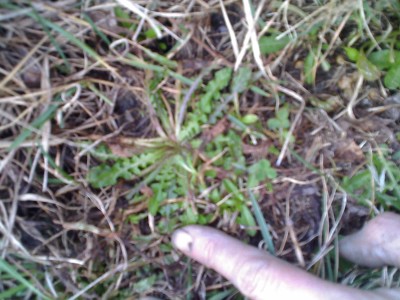
This is an older plant, with a big taproot:
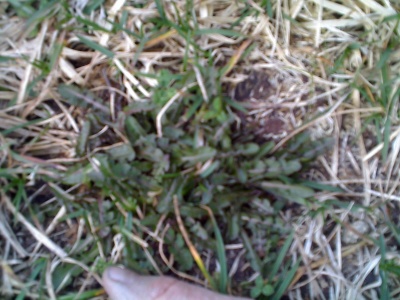
.

